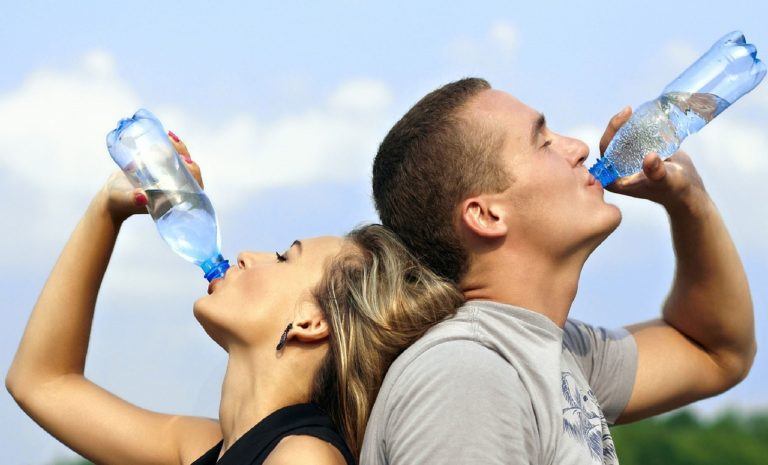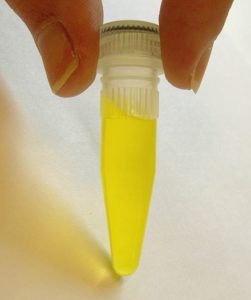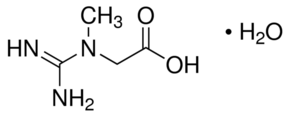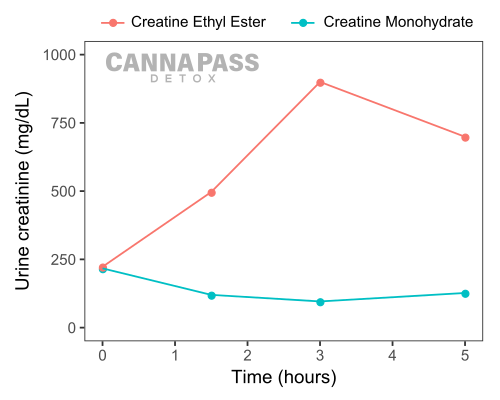
Urine Dilution
There is one thing that is universally agreed upon when it comes to beating a urine drug test for THC: you should always drink a lot of fluids right before the test. Every other method has its supporters and detractors, but nobody will deny this one works, and rightly so.
Beating a drug test is all about getting your urine THC metabolite levels below the concentration cutoff. Drinking more fluids increases urine output, but it does not increase excretion of THC metabolites. So doubling urine output cuts THC metabolite concentrations by half, quadrupling urine output cuts THC metabolites by 75%, etc.
The primary risk of this method is that the testing lab will determine your sample is too dilute and reject it. However, I will show you how to dilute your urine to the maximum extent possible without triggering them to reject your sample.
[Note: this page gives background and rationale for this method. For the actual instructions, see the 3 Hour THC Detox Protocol.]
Hydration Rate
I recommend starting hydration about 3 hours before a test. Some people recommend starting 6 hours before or even the day before, but this is excessive. You only need enough time to boost your urine output and urinate a few times before the test to clear out your old (more concentrated) urine.
I’m assuming that you are starting from a reasonably hydrated state to begin with. If you do a trial run and you didn’t urinate at least a few times in the 3 hours, then I would extend the hydration time to 4 hours.
A quick note on diuretics: you can take a diuretic if you want, but there is really no need. Drinking a lot of fluids is enough to increase urine output to the proper level. Adding a diuretic on top of this won’t do much more.
I recommend consuming fluids at a rate somewhere between 0.5 liters and 1 liter per hour. The exact rate depends on body size and how much dilution you need. Your kidneys typically can’t remove more than 1 L/hour of fluids anyways, so consuming more than this rate will cause you to accumulate water.
Average urine output is about 50 mL/hour (but it can range from about 30-80 mL/hour). After 3 hours of drinking excess fluids, your urine output will be about equal to your hydration rate. So if you are drinking 0.5 L/hour, you will pee about 0.5 L/hour, which will make your urine significantly more dilute.
Visual Appearance & Vitamin B2
The first thing a lab tech will do upon collecting the sample is a visual inspection. A very clear looking specimen may arouse the suspicion of the collector and trigger additional testing.

This issue is easily countered with vitamin B2. Vitamin B2 (also called riboflavin) is water soluble and excreted by your kidneys. Around 300 mg of Vitamin B2 taken 3 hours before the test is generally enough to add color back to your urine.
Specific Gravity & Electrolyte Solution
Specific gravity is a test that can be run to see if your urine is overly diluted. Specific gravity is a measure of your urine density, which is determined by the concentration of solutes in your urine. Basically, any molecule that is dissolved in your urine will increase its specific gravity.
There are many electrolytes in your urine which contribute to its specific gravity. Your body is always trying to maintain the right balance of electrolytes. If you drink pure water, it will try to preserve its electrolytes and excrete little into the urine. This will lower your urine’s specific gravity, potentially leading to sample rejection.
Instead of drinking water, you should drink an electrolyte solution. By consuming extra electrolytes, your kidneys will excrete these with the excess fluid and keep your urine specific gravity in the normal range.
The normal range of specific gravity is 1.005 to 1.030 (pure water has a specific gravity of exactly 1.000 at 4 degrees Celsius). A typical cutoff for low specific gravity is 1.003. You need to stay above this. You can test your urine specific gravity using home test strips.
Urine Creatinine
Creatinine is a by-product of muscle metabolism that is excreted into your urine. Urine creatinine is typically used to measure kidney function, but it is also a way that drug testing companies measure whether you have excessively diluted urine.
The DOT and SAMHSA guidelines (which many drug testing labs follow) have a cutoff of 20 mg/dL for urine creatinine. If your value is below this, your sample may be rejected.
The issue is that normal urine creatinine levels can vary an incredibly lot from one person to another. A normal urine creatinine range is 20-370 mg/dL in males and 20-320 mg/dL in females. The greater your muscle mass, the higher your urine creatinine is likely to be.
So you can see that if your creatinine levels are at the lower end of the normal range to begin with, it won’t take much urine dilution to drop it below the cutoff. If you are at the higher end of the range to begin with, you don’t have as much to worry about. You could dilute your urine 10-fold and still be fine.
You can buy home urine creatinine test strips and test your urine yourself. But what do you do if your urine creatinine is too low or you just want an extra margin of safety to be sure? The next section will explain what to do.
Creatine Monohydrate
Creatine (note the spelling difference with creatinine) is the precursor to creatinine and it is available as a dietary supplement. People take this before a test in an attempt to raise their urine creatinine levels.
It seems that 95% of creatine is available as creatine monohydrate, although another form called creatine ethyl ester (discussed below) is also available.

People are usually talking about the monohydrate when referring to creatine. Many detox drinks included creatine monohydrate despite a lack of evidence that it causes short-term increases in urine creatinine. Even studies of multi-day loading with high amounts of creatine monohydrate showed only minor and inconsistent increases
- 20 g/day for 5 days did not significantly change urine or blood creatinine in active young males
- 20 g/day for 5 days did not significantly change urine creatinine in well-trained students. Serum levels increased 18%
- 20 g/day for 5 days did not significantly change urine creatinine in young active men and women. Plasma levels increased by 22%
- 30 g/day for one week raised serum creatinine by 22% and urine creatinine levels by 47% (although the difference in urine wasn’t statistically significant)
- 0.1 g/kg lean body mass/day (6-8 g/day) for one week did not significantly change urine creatinine in male college athletes
Needless to say, I do not recommend creatinine monohydrate. Instead, you should use the other form, creatinine ethyl ester, which I discuss next.
Creatine Ethyl Ester
Creatine ethyl ester is similar to the monohydrate, but it has an extra ester group, which can be seen on the right of the structure.

You may not have heard much about this form, because it is generally not preferred for exercise performance. It appears that the creatine ethyl ester is directly converted to creatinine in the blood. Bad for bodybuilders, but good for you!
Now a recent study has done a head-to-head comparison of creatine monohydrate vs. ethyl ester for raising serum and urine creatinine levels.

 The ethyl ester performed beautifully – a single 10 g dose quickly raised serum and urine creatinine levels. Peak urine levels were reached in 3 hours, with a maximum increase of about 400%. The increase was seen consistently in every subject.
The ethyl ester performed beautifully – a single 10 g dose quickly raised serum and urine creatinine levels. Peak urine levels were reached in 3 hours, with a maximum increase of about 400%. The increase was seen consistently in every subject.
The monohydrate performed poorly. Although serum creatinine levels went up, urine creatinine levels inexplicably decreased by over 50%! So not only does the monohydrate not help you, same-day use of it may actually work against you. After seeing this result, I would be cautious with any detox drinks that contain the monohydrate.
Example of Using Creatine Ethyl Ester for Urine Dilution
“Joe” has a test coming up in 2 days and he is very nervous that he will not pass.
Joe uses a 5 level home test and determines that his urine THC metabolite level is as high as 200 ng/mL (the cutoff is 50 ng/mL). He uses urine creatinine test strips to determine that his baseline urine creatinine level is about 150 mg/dL.
To reduce his THC metabolite levels down to 25 ng/mL (he wants some buffer room after all), Joe calculates that he needs to increase his urine output by 8-fold. So he increases his fluid intake from his usual average of 100 mL per hour to 800 mL per hour for 3 hours before a home test.
Joe passes this home test (yay!), but measures his urine creatinine and discovers that he is below the 20 mg/dL cutoff. If this were a real test, the lab would not have accepted this sample.
The next day, Joe tests taking 10 g of creatinine ethyl ester. 3 hours later, his urine creatinine level is up to 750 mg/dL. He calculates that even with the 8-fold urine dilution, his urine creatinine levels will be well above the 20 mg/dL cutoff.
On the day of the real test, Joe repeats his dilution procedure but he also takes the 10 g of creatinine ethyl ester. His sample is accepted as having normal urine creatinine and he passes the test. Creatine ethyl ester just saved Joe’s ass!

